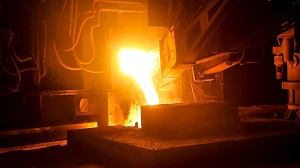What is calm steel?
Steel made in furnaces or converters is poured into steel molds (special molds made of cast iron), where it cools and solidifies. When it is poured into steel molds and the iron oxide content is too high, the steel shows the “boiling” phenomenon, which leads to the production of gas inclusions as structural defects. The amount of oxygen must be reduced to the limits accepted by the solidification process, this being done by deoxidizing the steel (also known as calm steel). To obtain steels with higher strength and toughness, deoxidizing elements are added, among which manganese, silicon and aluminum. Calming increases the price by 10-15%.

Depending on the degree of deoxidation, steels can be divided into three categories, symbolized by letters:
n – rimmed steel
s – semi-calm steel
k – calm steel
A rimmed steel is one in which the oxygen content is reduced to allow the carbon oxidation reaction to take place to a certain extent, after being poured into the steel mold. Deoxidation with manganese, silicon, aluminum, etc. is not enough in the case of rimmed steel (n). The chemical composition of these steels contains carbon between 0.04 – 0.09%, silicon between 0.005 – 0.002% and manganese between 0.25 – 0.04%. Due to the low consumption of deoxidizers, these steels are cheaper than calm ones and have a high plasticity.
Semi-calm steel (s) is an intermediate variant between non-calm and calm steel. The presence of carbon varies between 0.15 – 0.25%, silicon between 0.01 – 0.1% and manganese between 0.85 – 1.2%. The strength properties have values between those of the calm steel and the non-calm steel.
Calm steel (k) is the steel completely deoxidized. After it is poured in steel molds, the boiling of the steel stops because the amount of oxygen is too low. Deoxidation is performed with manganese, silicon, aluminum and other deoxidizers. Calm steel, the most commonly used, has a carbon content between 0.04 – 0.6%, silicon between 0.15 – 0.50% and manganese between 0.6 – 1.6%. This type of steel has good quality, a homogeneous structure and good strength characteristics, but it has low plasticity.
Calming or deoxidizing of steel is usually achieved by two methods:
1. Deoxidation by precipitation
2. Deoxidation by diffusion
<< Inapoi